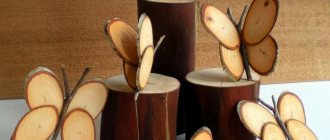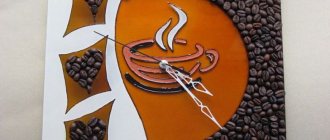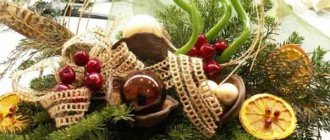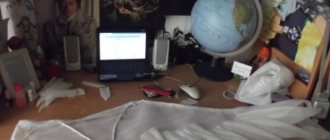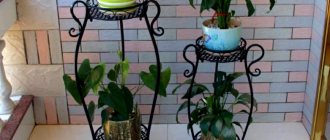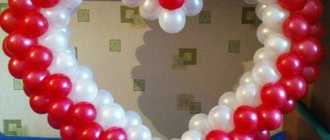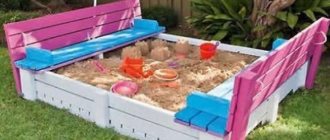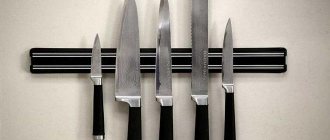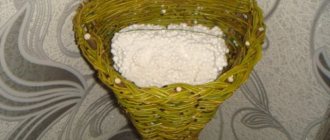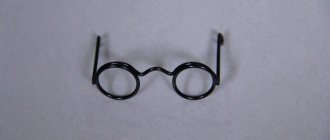Photographs are a repository of a variety of moments. They preserve life itself. That is why people always, even in the era of digital technology, put on the table, place on the walls photos related to a particular event or person. Spectacular and unusual photo frames are not cheap, but everyone wants to decorate their home with a noticeable decorative element. Therefore, the decor of photo frames has always been, is and will be in demand. Decorating frames with your own hands is possible for almost everyone; it is exciting and makes you feel like a real creator.
Paper photo frames
How many things can you make from paper? Countless products, interior items, crafts and much, much more. The Internet is teeming with ideas, each better than the next.
Photo frame using origami technique
Required materials: - colored single-sided paper; - scissors; - a simple pencil; - PVA glue; -ruler.
The base is 4 squares 15x15 cm. Fold the square diagonally with the colored side inward. Expand. Place the square face up and fold the bottom side of the square towards the fold line as shown in the photo. Turn the workpiece over and bend the bottom corner. Turn the workpiece over to the front side and bend along the fold line. Turn over. And fold the bottom part along the fold line.
Place the side in the pocket. The module is ready.
Reverse side of the module.
To assemble a photo frame we need 4 modules.
Apply glue to a sharp corner and insert it into the corner of the 2nd module, as shown in the photo. Then the 3rd and 4th module. The photo frame is ready.
Reverse side of the photo frame.
Insert any photo or funny picture.
Three-dimensional photo frame
The good thing about this frame is that all you need to create it is a sheet of paper and scissors. What’s also great is that the frame is voluminous.
The size of the frame depends on the size of the sheet of paper. This means that you can make a frame of any format. And use it to post a photo or collage, as well as to decorate handmade crafts.
Print the frame template
If you don't have the opportunity to make a printout, then make a template for a homemade paper frame with your own hands. To do this, you need to place a photograph in the center of the sheet and trace its outline (or simply draw a rectangle of the appropriate size in the center of the paper). Then set aside strips of different sizes (alternating strips 1.5 cm and 1 cm wide). Make indentations at the top and bottom as shown in the template.
Next, we bend the drawn strips along the ruler. We begin to wrap the sides of the future paper photo frame. We do this carefully so as not to crush the craft. The short sides are folded first, followed by the long ones. We need to insert the corners of the long sides of the paper frame into the corners of its short sides to secure the structure tightly. If the paper is very thick and glossy, it makes sense to insert the photo first, and only then fold the sides. This way it will “sit” tighter. If you are worried about the design, you can drop a little glue or use double-sided tape.
Paper frame using quilling technique
Option 1:
For work you need to prepare tools and materials:
- photo frame made of light wood.
- acrylic paint white
- sponge or sponge for applying paint
- quilling paper white and blue - strips 3 mm wide
- tweezers for quilling
- quilling awl
- scissors
- PVA glue
- glue Moment
- acrylic contours - imitation pearls - white and blue colors
Let's start by preparing the frame. It is better to take a frame made of light wood. Then you don’t need to prime the frame first, and the white paint will fit perfectly on the wood. If the frame is made of dark wood, you will need to apply primer first to disguise the dark color of the wood. Remove the glass from the frame. Using a sponge, apply paint to the frame on all sides using a blotting motion. It is better to apply 2-3 layers. And leave the frame until completely dry (after 1.5 hours the frame will be completely dry).
While the frame is drying, we will prepare the decorative elements with which the frame will later be decorated. Let me immediately note that when creating such elements there are no uniform schemes or rules. All this is purely a flight of imagination and mastery of working with paper. We take 8 strips of white color and glue them together with a ladder, that is, each strip is glued to the previous one with its tip, while the tip of the strip is located slightly lower. Using an awl, we twist the glued strips, while wrapping the strip so that the gluing points are inside.
Unravel the twisted roll. This is such a beautiful curl. Now we glue all the strips together in one place, just below the curl. When the joint is dry, we give the strips a wave shape and glue the strips together again. We cut off the remaining free ends so that each strip is longer than the other. And twist each end. Please note that this is a large complex element. Now we glue this element to the already dried frame. The element can be bent to fit the frame. In the decor of this frame, I wanted to play up 2 colors - white and blue, as well as a smooth transition from one color to another, so let's start creating a central element, but in blue. We glue 6 strips of paper together with a ladder and roll them into a roll. Glue the strips together in one place. We cut the ends in the same way as the white element: each strip is longer than the previous one.
And we wind each strip onto a quilling awl.
Now we unwind the previously twisted rollers. This is easy to do by running an awl over them. Now we glue this element to the frame. It is better to use instant glue for this. At the same time, we glue this element in the upper left corner, as in the photo. We straighten the curls so that they lie in the same plane and glue them. In order to make a smooth transition from one color to another, we glue strips of white and blue, 4 of each color. And twist it into a curl.
Glue it to the left side of the frame.
To fill the voids, we make and glue curls to the frame. On the left are white, on the right are blue. Add another blue curl, but this time larger. Now let's go back to the bottom of the frame. For decoration we twist a lot of small curls. To do this, cut the strip into pieces of arbitrary size and twist the ends. We glue the elements so as to fill the entire space.
I always encourage people not to be afraid to combine different techniques, and in this case I used acrylic outlines for painting. Using an outline with imitation pearls of a natural color, we place a series of dots. The size of the dots increases, from smaller to larger. In the upper part of the frame, where the swirls are blue, draw dots with a contour of a suitable shade. I drew wavy lines so that one color of the dots smoothly transitions into another.
And here is the result.
Place your favorite photo in a frame and let it please your eyes for many years to come.
Option 2:
To make a quilling photo frame you will need the following ingredients:
- thick paper for the background (minimum 300 g/m2) - less dense paper for flowers (from 120 to 160 grams/m2 - thicker is not advisable, because stripes of this size will not curl so obediently and smoothly) in two colors. In my case, it's white, which will stand out, and a more subtle shade of the background color, which will allow our flowers to blend better with the main color and help highlight the details. - a paper knife and a steel ruler for cutting strips. Cutting with scissors is a tedious task - PVA glue - toothpick or other device for twisting rolls
We cut strips 30 cm long and 5 mm wide, and estimate the quantity based on the plot we have planned. There are many clever ways to cut quickly, such as cutting multiple layers of paper at once, but at this density (120 to 160) it is quite difficult. Therefore, in order not to be too tricky for a long time, I fastened the paper for the flowers with a notebook sheet in a cage and, Whack-Whack-Whack, moving the ruler across the cells, but first we’ll make a frame, and the best part will be for later.
We mark our densest leaf. I recommend that you first draw up a detailed diagram on paper so as not to cut off too much and take into account all the dimensions. I was counting on a 13x18 photo, based on these dimensions we choose the width of the frame, mine on the left and bottom is a little wider. Having finished marking, we cut out a window for the photo, which should be slightly smaller than the photo itself.
Now let's take care of the “pocket” into which the photo will be inserted. Photo paper is very thick and has a significant thickness, so to prevent the frame from deforming when a photo is inserted into it, we will give the pocket a little width. We glue a narrow strip of thick paper on the back side, and now we can glue the “pocket” itself, which will prevent our photo from falling out of the frame.
The base is ready
Let's move on to the flowers. So, to make a petal we need a strip of paper, which, using a split toothpick (or a more noble tool), is rolled into a tight roll. The roll, in turn, is unrolled to a certain diameter, then the end of the strip is fixed with PVA glue and the roll is given the desired shape using your fingers. We wash our hands so that there are no offensive dark spots at work later. The sections of the strips get dirty especially easily; for white paper this is simply a disaster; it can easily give it a very poor appearance.
To make identical petals, it is convenient to use a template to unwind the rolls to the same diameter.
I also really like flowers of this shape and leaves, of course
In general, we twist as much as we like, don’t forget to create flora of various sizes. When the main elements are ready, we place them on the frame and glue them. This is not the final version, but I think the meaning is clear.
Now we add details until the composition seems complete enough.
The last step remains - attach a stand to the back for stability.
The frame is ready!
Photo frame made of paper tubes
Option 1:
We will need:
- old newspapers or magazines;
- base frame;
- glue;
- wooden skewer;
- scissors.
Before making a frame from newspaper, you need to prepare several dozen tubes.
To do this, divide the printed publication into separate sheets, and then, starting from the corner, wind each sheet onto a wooden skewer. To secure the tube, coat the corner of the sheet with a small amount of glue. Wait until it dries and carefully remove the skewer. Make several dozen more paper tubes in the same way. In our example, about 55 such tubes will be required.
Check if the tubes are long enough to cover the frame. If they turn out shorter than required, glue two tubes together by inserting one into the other. Now you can start creating a frame from newspaper tubes. Apply a thin layer of glue to the base frame. You can use a primer if the base color doesn't suit you.
Lay the tubes parallel to each other so that there are no gaps between them. You can stick the tubes vertically, horizontally or obliquely - it all depends on your imagination.
Glue together four tubes into a rectangular frame, the size of which corresponds to the photograph or painting you plan to display. Carefully remove the ends of the tubes protruding beyond the edges of the frame, and the craft is ready!
Option 2:
We cut strips along the entire length of the sheet, i.e. 30 cm. Strip width 5 cm. It is better to use glue that is not liquid. And you will need a wooden stick. We place the stick so that the ends of the strips remain empty, mine are 5 cm. Twisting a tube in this way is not as easy as it seemed to me at first, and I came up with my own method, which I share with you. First step. First we make a side in the shape of a stick. This makes it easier to glue it on later. If you don’t have such sticks on hand, you can replace them with paper tubes. Which are twisted for weaving. For us, the main goal is a frame made of straight tubes (no twists). Step 2. Rub the stick with pencil glue on all sides and glue the side to it. Let it sit (the stick and paper should stick together), while we glue the next one. And so we made the preparations and proceed to the next step.
Step 3. We make the first turn of the stick, pressing firmly and straightening the ends of the tube.
Then don’t try to twist it too tightly, you’ll only wrinkle the paper. You just need to give it the shape of a tube. Then on the floor on a mat, start rolling the sausage (as with dough), first lightly, then you will feel that it is curling up. Then you press firmly and roll until you feel the stick. Try to ensure that the ends where there is no stick are the same thickness as the center. And also, if you roll a tube and it doesn’t curl, it means the stick has come unglued. Step 4. Secure the tube with clothespins. Clothespins have two sizes of recesses, we fix them in the second - smaller one. Possible for three clothespins. Step 5. First glue between the clothespins, then remove them and finish gluing where the clothespins were. I carefully glued it with PVA glue with a needle. The tube is ready. This way I glued two tubes together. The tubes, if glued this way, will not move. They will be even. I applied the glue with a toothpick between the tubes directly from the top. And also, don’t forget to lay all the tubes with the seam facing up - this will be the wrong side. My clothespin only fits two tubes into a large recess. These are the stripes we got for the frame. One photo is missing of how I glued 4 tubes together. It’s already simple, cut out a strip no wider than 4 tubes and glue it on it. I needed a frame for this picture. I laid it out as I saw fit and measured the internal size. I made a mark along the ruler from corner to corner and cut with a very sharp knife. I cut out a corner and glued it onto it. I constantly measured the frame so that it wouldn’t turn out crooked. And here is the corner. It worked! Photo frame made of bamboo-look paper
For a bamboo frame, you need thin, dense tubes of foil or cling film. The tubes may differ slightly in diameter - this is bamboo, and in nature it can be different.
I cut the tubes, but it seems to me that whole ones are also possible, for example, I saved money because I didn’t have many tubes and I like it better when the flat side is near the frame. First fitting. The stretcher was glued together from 2 corrugated cardboard sheets, the front side was covered with velvet adhesive film, and the back side was covered with wallpaper. On the top crossbar you can see that the sizes of the tubes are different.
Each prepared “stick” was pasted over with pieces of some kind of wrapping paper (found in bins). A jute rope was glued under the paper in several places (future jumpers - bamboo rings). Where the difference between the diameters of the tubes, I also wound a thread, having previously glued the tubes by overlapping smaller. Cover the glue-dried tubes with brown putty (I covered everything well with my finger, paying attention to the jumpers). When the tubes were dry, I carefully sanded them with fine sandpaper. In the places where the jumpers were, I used a brush with brown paint and, without waiting for it to dry, I seemed to stretch the paint away from the jumpers, thereby making the color transition smooth and natural.
DIY photo holder.
Every family has photographs that are most dear to us as memories, and often we want them to be in plain sight and not stored in an album. Of course, there are frames for this, but often they are large and there is not always room for them. You can make miniature photo holders with your own hands. The material for them is the simplest, they are made quickly, and their design will give you great pleasure, especially since you can decorate them using almost any technique available to you: scrapbooking, quilling, decoupage, paper art, etc. So let’s begin. We need two cardboard blanks measuring approximately 8 by 8 cm, two wooden clothespins, PVA glue and double-sided tape.
Instead of cardboard, you can take these plywood blanks. These are actually coasters for glasses.
I decorated my blanks using decoupage technique. I used a rice card and made a craquelure.
I also decorated the reverse side.
I also tinted the clothespins to make them look completely aesthetically pleasing, but this is not necessary.
And then everything is very simple. We glue our clothespins onto one of the blanks. Regular PVA glue.
This is how our future photo holder will stand.
Next, to stabilize the photo holder, we glue double-sided tape to the clothespins. The distance between the workpieces will become wider and the holder will be more stable.
We attach the second blank to the tape.
That's all. The photo holder is ready!
Let's add some more plastic roses and you can insert a photo. To do this, squeeze the lower part with your fingers, the clothespins will open and clamp your photo.
This holder is made using scrapbooking technique.
Here, as you can see, for greater stability I did not use tape, but an additional third clothespin, divided in two. It is more stable.
You can put the whole photo.....
Or you can (if you don’t mind the photo) cut off the excess and place it in a homemade frame like this.
Well, and one more, again using the decoupage technique. This is the front side.
On the reverse side I used the same napkin, but without additional details.
stranamasterov.ru
Cardboard photo frames
Option 1:
Creating beautiful frames without the appropriate equipment is problematic. Therefore, collect a minimum set of tools. It should include:
- large scissors;
- stationery knife;
- PVA glue;
- a simple pencil;
- scotch;
- small scissors;
- fine-grained sandpaper;
- ruler.
Note: it is advisable to get a cutting mat; it makes it much easier to mark out the parts of the future frame.
If you are not happy with the color of the cardboard for the frame, purchase a can of spray paint. To decorate photo frames, use shells, pebbles, glass, rhinestones, beads, etc.
In addition to the basic tools, you will need: a paint brush with soft bristles, a spray bottle, water and tongs. They will be needed to prepare the material for use.
Preparation of material
The best material to make your own photo frames is cardboard. Why? It is cheap and easy to process. Every home has at least one cardboard box and glue with scissors.
In its raw form, cardboard is of little use for making a photo frame. Its preparation comes down to the following: separate the top layer so that the corrugated part appears.
Sometimes this is not easy to achieve, since different types of cardboard are made with different amounts of glue and they have different thicknesses.
How to quickly peel off the top layer of cardboard:
- Wet the part of the paper that needs to be removed. Distribute the moisture evenly over the surface using a brush. Wait 2-3 minutes for it to soak. Using your fingers or a knife, pry up the edge of the layer and try to remove as large a piece as possible. Cut off the rest. Clean off dried glue with sandpaper.
The method described above is applicable to large pieces of cardboard; for small ones, sometimes it is enough to rub the top layer.
Note: Be careful when spraying water.
If you overdo it, the cardboard will become soggy. At best, you will have to wait until it dries. At worst, start the work all over again. Instructions
First you need to decide what kind of photo the frame is being created for. It is not the content that is important, but the size and orientation of the card (vertical or horizontal). Based on this, proceed:
Step #1. Cut out the base.
Cut out the base of the frame from a large piece of cardboard.
Its dimensions should be at least twice the size of the photo. Next you will understand why. Using a ruler and pencil, mark the contours of the future part. Then cut it out with scissors. Step #2. Making a compartment for photography.
In the middle of the base, draw a rectangle slightly smaller than the photo for which the frame is being made. Carefully draw along the outline with a stationery knife and cut out a window.
Cut out a rectangle that will cover the photo hole on the back of the frame. Glue the door with tape on one side.
Step #3. We complete the preparation.
Make several cardboard strips of different lengths. Stick four of them around the photo compartment. Use the rest to create the structure of the front part. For clarity, look at the figure below.
To make the frame fit more tightly to the wall, glue triangles at the corners of the back. They compensate for the thickness of the door and allow the photo frame to hang more evenly.
Making triangles couldn't be easier. Cut one out using a pencil and then use it as a stencil.
Step #4. Decor.
Everything we did before had little to do with creativity. It's time to turn on your imagination to the fullest. Here is one of the options for designing a frame, but this is just an example, you can come up with your own version.
So, to decorate the photo frame we use the same cardboard. Take the prepared material with bare corrugation and cut it into ribbons. Divide several of them into elements as shown in the figure below.
Next, glue the decorative parts onto the front of the frame. The result is an asymmetrical relief pattern. This photo frame is unique and, with the proper approach to manufacturing, will outperform its designer counterparts.
Additional photo frame design options are:
Traditional photographs have an energy that digital images lack. Enclose them in frames made by yourself. This will make the captured moments of life brighter and the design of the room unique.
Option 2:
You will need: corrugated cardboard, self-adhesive paper, scissors, ruler, pencil, colored paper napkins or corrugated paper, stationery stapler, thermal gun, photograph.
From cardboard we cut out 2 rectangles 16X20, one 5X15. On one of the rectangles in the center we draw another rectangle, retreating 3 cm from the edge, the inner rectangle is 10X14.
We place our rectangle on self-adhesive paper, trace it with a pencil and add 2-3 cm, as shown in the figure, cut out and carefully glue two large rectangles. We cut a small rectangle (hereinafter referred to as the holder) from one edge diagonally as in the picture and also paste it over. To make flowers from napkins, we will need 9 napkins, from which we will get 18 flowers. Cut the napkin into two parts exactly in the middle. Cut out a circle with a diameter of 5 cm from cardboard. Fold the cut napkin in half and fasten it with a stapler. Let's circle our circle.
Next we cut out and shape the flowers.
Using a heat gun, glue the holder onto the entire rectangle from the glued side.
On the other side we paste a photo.
We assemble the frame by gluing both parts and flowers.
Decorative hearts
An origami photo frame decorated with hearts is a great opportunity to say: “I love you!” the closest people. To understand how to make such a paper decoration, it is best to watch the video tutorial:
For a frame measuring 7.5x7.5 cm you will need a square sheet of 15x15 cm. From the “heart” modules you can fold a ribbon-hanger:
Or add side triangular supports and place the photo on the table:
To place a photo in an origami frame, it must be cropped to 3.5x3.5 cm. If the photo is larger, the original square of the module will have to be proportionally enlarged.
But the most interesting option is obtained when a volumetric cube is assembled from photo frames.
An origami photo frame decorated with hearts can be a touching gift for Valentine's Day. Especially if you complement it with other similar decor.
Wooden photo frames
As you know, wood is an ecological, expensive and exquisite material.
Wood in any interior emphasizes aristocracy. By placing a wooden product in our home, we get a little closer to nature.
Step 1: Materials
You will need a couple of pallet boards for the project, although any other wood will do. In my case, the slightly weathered look of the pallet wood goes perfectly with the equally time-worn sign, so I used that. If you want to achieve a more polished appearance, then pallets can also be used, you just need to sand the boards thoroughly and, for example, coat them with varnish or paint.
For the back wall of the frame you will need something flat, such as MDF or hardboard. Thin plywood or thick cardboard will also work. The only requirement for the back wall is dimensions. The dimensions should be slightly larger than the visible area of the frame, and smaller than its edges. In other words, it can be the size of the frame, but a couple of centimeters smaller on each edge.
Step 2: Attach the object of adoration
Our frame is not quite ordinary; it will not be possible to insert glass into it, behind which the photo is placed. Since there is no glass, you will have to glue it down to prevent the photo from falling out. I used a car sign instead of a photo and glued it to the MDF (back wall) with hot glue.
Glue can be any kind, but with hot glue it goes faster.
Step 3: Cut out the frame
Now we need a ruler, and basic skills in working with a hacksaw (which all men have by default from birth). All you need to do is measure the length of the inner edge of the frame on the board, and draw 45-degree angles, and then cut the board along them.
Step 4: Putting all the pieces together
I just hot glued each side of the frame to the back panel and that was it. As you can see, there are small gaps between the boards, and I like this look even better.
Step 5: Glue it a little more
Along the edges of the back wall I applied another thin layer of glue for additional adhesion.
Step 6: Frame Mounting Hole
The hole for fastening is made from the back side, and the main thing here is not to make it through.
Step 7: Finishing Touches
Photo holder - 5 ideas that you can implement yourself
Each of us has not the best days - when we just want time to quickly come to the evening, so that we can hide at home, so that, having changed into slippers, we can leave all our problems and troubles behind the threshold. How do you save yourself on days like these? It has long been proven that needlework is one of the best relaxing procedures. Try making a photo holder with your own hands - during the process you will be so carried away that you will forget about all the possible troubles and difficulties. In addition, later, when the photo holder is ready, when returning from work, you will always meet the eyes of those dear to you, and this is a separate plus.
Photo holder - 5 ideas that you can implement with your own hands:
1. Photo holder - mountain
The people you love deserve the best, the highest! Make each of them their own Everest - all you need is polymer clay, paint and diligence. Just start working - and you are guaranteed a good mood; it will come on its own, displacing the worries and worries of the past day.
Master Class
2. Macaron holders
Do you like macarons? Bright, juicy, incredible! Just looking at these delicious cakes will lift your mood and improve your well-being! Imagine how much you will want to smile if, in addition to your unrealistically attractive appearance, you can also see the beloved faces of your children, parents, and husband. Definitely do it!
Master Class
3. Heart holders
What could be sweeter and kinder than a simple naive heart that holds, as if hugging, a photograph of a person dear to you? Make such a photo holder on your desktop - and any negative thoughts will disappear before they even have time to form words. This is a simple project, but there is a lot of meaning hidden in its simplicity.
Master Class
4. Photo holders made from wooden blanks
Do you have a wooden cube or ball on hand? Be sure to twirl them in your hands, take a closer look at the patterns that nature has created, and then, having figured out how to best play with them, decorate them and turn them into stylish eco-friendly holders for family photos. Very warm, sincere things for the warmest relationships.
Balls, cubes
5. Stylish holders made of clothespins with decoupage
And this project definitely deserves the title of the most relaxing! It contains everything: creative search, fine motor skills, selection of the most delicate materials, and calm, unhurried, almost meditative work. Choose the motive that best suits the state of your soul, and create for pleasure!
Master Class
Discussion of the article
You can rate the article, share your opinion, and subscribe to comments on the article.
What else to read on this topic on the Handicraft Runet:
www.darievna.ru
Frame made of tree branches
We will need:
- thin branches;
- cardboard;
- glue gun or superglue;
- moss (real or decorative);
- decorative flowers;
- acrylic paints;
- craft varnish (optional).
To make such a frame, you need to take a responsible approach to the choice of material. Try to choose branches of one or two sizes (thicker and thinner). It is better not to take twigs with slippery bark, as over time they will begin to dry out, which will make them not very beautiful. And it’s more difficult to work with slippery bark. Dry branches collected from the ground rather than plucked from trees are best.
The blank for the photo frame needs to be cut out of thick cardboard (and several layers glued together) or plywood. Next, paint the future frame brown or any other color. The main thing is not to leave it white, as it will not look very nice.
Free the branches from excess bark and straighten them. Cut to frame size. Place four thicker branches as the first layer and glue them.
Next, lay out another layer of branches. Increase their mass on the photo frame gradually, gluing each one separately. If you are using superglue, the reliability of which you are not too sure of, fasten the branches together with wire. It is advisable to choose wire of an inconspicuous color or completely cover the finished photo frame with spray paint so that the fastenings are not noticeable.
Glue moss around the edges of the frame. If you don't have anything similar, add leaves or pine cones that can be pre-painted.
Add decorative flowers or beads, painting them with acrylic to decorate them with berries. At the end, the craft can be sealed with non-toxic wood varnish.
Stripping plywood
We clean our plywood with sandpaper. As you already know, “Medium-grained” and “Fine-grained” sandpaper is used for cleaning plywood when sawing. You've probably seen sandpaper in hardware stores, and that's what we'll need. In your work you will need “Coarse-grained”, “Medium-grained” and “Fine-grained” sandpaper. Each of them has its own property, but a completely different coating, by which it is classified. “Coarse-grained” sandpaper is used for processing rough plywood, i.e. which has many defects, chips, and cracks. “Medium-grained” sandpaper is used for processing plywood after “Coarse” sandpaper and has a slight coating. “Fine-grained” or otherwise “Nulevka”. This sandpaper serves as the final process for stripping plywood. It gives the plywood smoothness, and therefore the plywood will be pleasant to the touch. Sand the prepared plywood in stages, starting with medium-grain sandpaper and ending with fine sandpaper. Sanding should be done along the layers, not across. A well-polished surface should be flat, completely smooth, glossy in the light and silky to the touch. How best to prepare plywood for sawing and which sandpaper is best to choose Read here. After stripping, check the plywood for burrs and small irregularities. If there are no visible defects, then you can proceed to the process of translating the drawing.
Photo frames made of coffee beans, shells
Coffee beans
Coffee beans will be useful to you not only for making an invigorating drink, they turn out to be an excellent material for decorating a photo frame with your own hands: they have a wonderful smell, an original texture, a noble color, and they do not spoil. The work won’t take much time either: it’s not so difficult to use a glue gun or PVA glue to tightly line a standard photo frame with coffee beans, which in its new guise is guaranteed to become a leading interior accessory.
To make your handmade frame smell fragrant, buy star anise and star anise and find a place for them in the overall decor.
Shells
This is one of the rewarding materials for decorating a photographic frame with your own hands. For decoration you need shells of various shapes and sizes. In addition to shells, it is appropriate to use interesting pieces of glass, sea pebbles and other finds made on the sea or river shore in inlay.
Process Features
There are no restrictions as such when choosing material for the frame. The base can be made from different items, and choose decorative decorations at your discretion . The only condition is that the material must be strong and dense. The simplest option is old boards, from which you can easily make a frame of different sizes. The finished product needs to be painted or varnished so that it fits perfectly into almost any interior.
DIY photo frame
For decoration, improvised means can be suitable, for example, beads, small clothespins, sea pebbles or even pasta. You need to choose the material for decoration so that the finished frame complements the picture. For example, if the photo was taken on the beach, then it would be logical to decorate the frame with small shells or pebbles.
Original options for photo frames
Foamiran photo frames
Materials and tools
To make bright butterflies, prepare:
- foamiran (plastic suede) 2 mm thick, black and two types of color;
- thin white and lilac foamiran;
- glue "Moment";
- scissors;
- pastel;
- pencil;
- paper;
- cotton buds;
- knitting needle
Manufacturing technique and photo
On paper folded in half, randomly draw a template with a pencil - half the silhouette of a butterfly, or download a ready-made picture. You can transfer the silhouette of an insect from a book or children's coloring book.
Cut out the pattern with scissors, lay it on black foamiran, trace it with a knitting needle, lightly pressing on the plastic suede. The material for the base can be dark blue, brown, the main thing is that the top layer is much lighter. Repeat for a different size and shape. Fold the paper template in half again and cut out another silhouette that follows the contours of the first, retreating 2-3 mm from the edge. Repeat with another paper pattern. Cut out all four butterfly silhouettes from foamiran. Make decorations from thin material of different shades. Tint the top blank with pastel, placing it on a slightly damp cotton swab. Color without using strong pressure, the movements should be light to get natural “live” shades. Apply colors symmetrically - in nature, these insects are always mirror-like. Also color the detail of the second butterfly. Fold the painted parts in half and randomly cut them into equal parts. Immediately arrange the resulting elements on black symmetrically, otherwise it will be difficult to choose the same ones later.
If desired, also cut the resulting shapes into smaller ones.
The smaller they are, the more interesting the pattern of the wings will be. Lay out the entire pattern of the wings and begin gluing the decor to the base one by one. It is advisable to work from the edge to the center, leaving a small black gap between the workpieces. This will create a volume effect and make the craft more interesting.
Try to ensure that all elements are glued symmetrically. Remember the perfection of nature.
Now you need to prepare the photo frame. From thick foamiran, cut out two circles that make up the base of the frame; in this master class, the diameter is 22 cm.
Make a smaller hole in one of them (for the desired photo). Cut out a blank that fits half of the top photo frame. Glue it to the bottom base of the photo frame. Glue the front part on top. Follow the instructions printed on the glue tube. Glue the resulting butterflies onto a photo frame, choosing good places, as in the photo. Cut randomly small butterflies from colored foamiran for additional decoration of the photo frame and stick them on the front part.
Apply pastel using the method already described on the frame and butterflies. Glue a magnet if the frame will be placed on the refrigerator or attach a holder for a photo frame. A photo frame with foamiran butterflies is ready to decorate your interior or become a gift.
Other creation ideas
In addition to plywood, you can use other materials to create a wooden photo frame. The simplest and most interesting option is to use popsicle sticks. With their help, you can make a frame and glue a photo on it.
No less simple and interesting is the use of a wooden plank to create a half-frame. Having secured the photograph to the base by the upper part, holes are made in it for a cord, on which the half-frame with the photo is hung on the wall. For a more complete mounting of the photo, it is worth attaching the same wooden plank at the bottom of the photo.
Another easy-to-use material is pallet wood, which can be cut into desired pieces, sanded and joined.
Each option has its own characteristics, so it’s worth trying your hand at creating photo frames from different materials, using various decorative elements. With each new work, the level of skill will tirelessly grow, and the products will delight with originality and beauty.
To learn how to make a photo frame out of wood with your own hands, see the following video.
